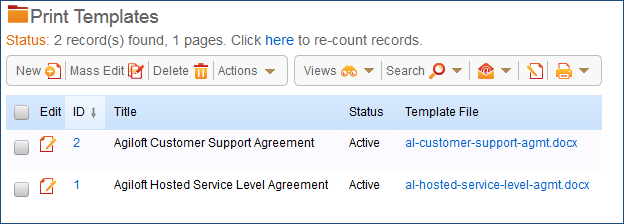Print Templates Table
The Print Templates table is a background table that holds a record for each print template used by the Contracts table or other system tables. It also keeps track of the Version Number of the attached print template document, and defines which Contract Types can use the print template in the Available for Contract Types field.
Use Case
Print Templates can be created and edited by admins and Contract Managers. The ID, Title, Template File, and Version Number fields are pulled into the Contracts table as a link to selected fields from another table. These are filtered to print templates whose Available for Contract Types field contains the Contract Type selected in the current Contract record. If multiple print templates are available for a Contract Type, the default value for the Print Template to Generate in the Contract is matched to the Default Print Template Title and Print Template File fields of the selected Contract Type.
An abbreviation field is used in the resulting file name, so it is useful to populate any new print templates with a reasonable abbreviation.
Inserting Variables into Print Templates
Print templates may include field variables from the table on which the template is run, as well as from any table in the system. For instance, a template might have the text $contract_start_date in the place where the start date of the contract should appear.
It may also pull in clauses from the clause library without creating a link to that clause within the contract. A special syntax is used for fields and records that do not live in the main table from which the template is run:
$field_from_other_table(clause,41,clause_text) is used to indicate that the Clause Text field (clause_text is the field name) for record with ID 41 in the Clause table should be inserted into the print template at this position. Please see the help article Print Templates: Resolving variables from any table's record for more details.
Conditional Text, Fields, and Content
There are several ways to insert conditions into a print template to use alternative text or alternative values. These are described in the Print Template Syntax Reference. It is common to have print templates with optional or conditional sections that may or may not appear when the template is run, based on meta data in the contract.
Numbering of Sections
If the print template is using HTML text fields either from the contract, or from clauses in the clause library, and you need section numbering with the contract, there are some special challenges with deciding what kind of numbering methodology to use. Auto-numbering can be used within the HTML clause field itself, within the template, or within the style used in the conversion.
In the standard implementation, we have examples of three kinds of numbering methods. These are managed in the following Print Templates:
NDA Numbered Normal Style is defined to use unnumbered clauses and the Normal style itself is configured in the template to use auto-numbering, so any clause included in the template will be numbered. This does not support subsection numbering.
Default NDA for clauses with numbering is a template without any numbering that is used with a set of clauses that have the Word auto-numbering codes in the clause text field. Putting the numbering codes directly in the clauses permits numbered subsections with the clauses, and there is an example of this for the governing law clause.
NDA clauses using table for numbering uses a Word table with two columns to hold the clauses. The first column has auto-numbering on and manages the number, and the second holds the clause text. The table shows no borders and is therefore invisible to users. This gives a nicely aligned look but can be a bit more challenging for users if they need to do a lot of editing of clauses and aren't familiar with working with Word tables. It does not support subsection numbering.
Agiloft Hosted Agreement with Adobe Sign Tags includes a user selected Governing Law clause (in the contract), and up to four optional clauses selected by the user in the contract (these are put in the final section). It also includes Adobe Sign signature tabs as examples in how to insert such tags.
Hosted Service Level Agreement Docusign Tags has the same Governing Law clause and optional clauses but uses Docusign (hidden) tags in the signing block instead of AdobeSign tags.
You may also want to refer to this article for further information on print template number and other formatting: Print Templates: Auto-numbering and bullets in MS Word templates.
Ownership
Print Template records are owned by their creator. Specifically, a Print Template record is owned by the user whose Login matches the Creator Login field.

